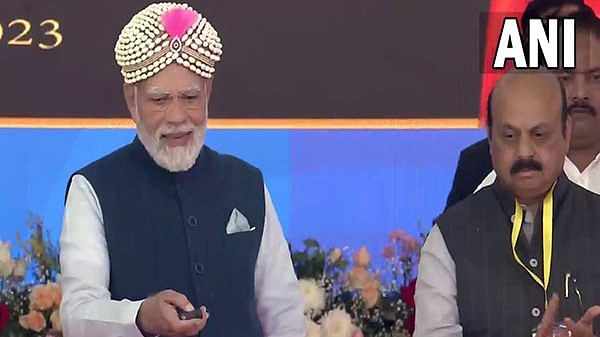Narendra Damodardas Modi was born in September 1950 to a low-caste family. He grew up with six siblings in a semi-finished house in a remote Gujarat village. When he was eight years old, he joined the Rashtriya Swayamsevak Sangh, the belligerent Hindutva organization. From that early start, he rose in prominence as a leader in Gujarat’s BJP. Modi jackknifed into the national and international consciousness in February 2002, when hordes of Hindus massacred Muslims under his watch as Gujarat’s chief minister. He showed little compassion for those who suffered and refused to condemn the riots.
Soon after the riots, though, Modi sensed political and economic trouble when business owners complained about the continuing Hindu and police violence against Muslims, civil rights activists, and journalists. Many businesses threatened to stop investing in Gujarat. In late April, an industry leader warned that not just Gujarat but India would “pay dearly” for the state’s failure to protect minorities. Veteran industrialist Rahul Bajaj sustained the denunciation. “Events like the Gujarat carnage will impede our economic progress,” Bajaj wrote in the Hindustan Times. At a conclave of industrialists in February 2003, amid a continuing chorus of criticism from businesses, Bajaj looked at Modi and asked him, “We would like to know what you believe in, what you stand for, because leadership is important.”
A furious Modi dismissed his critics as “pseudo-secularists.” He recast himself as a friend of business and began marketing Gujarat as a prime business location. In September 2003, with the help of the businessman Gautam Adani, Modi established Vibrant Gujarat, planned as a onceevery-two-years gathering to sell Gujarat to Indian and foreign industrialists. Adani and other businessmen—including Mukesh Ambani—signed agreements with the Gujarat government to fund and operate large investment projects.
Modi’s rebranding effort went national in 2004. A new phrase— “the Gujarat model of development”—became associated with him as he campaigned that year for the BJP’s Lok Sabha candidates (Figure 21.1). The narrative of Modi as a development champion grew exponentially.
In late 2006, Mukesh Ambani led a delegation of Indian businessmen to the United States to market “Vibrant Gujarat.” Modi, however, had set his eyes on a bigger prize: Ratan Tata, India’s most respected business name. An opportunity arose in 2008 when the frustrated Tata announced he was pulling his car manufacturing investment out of West Bengal because there was no meeting of the minds with the farmers protesting against his acquisition of their land. As Modi described it, he sent a three-word text message to Tata: “Welcome to Gujarat.” Tata did not disappoint. He became Narendra Modi’s brand ambassador, singing his praises to a worldwide audience on Fareed Zakaria’s Sunday morning program on CNN. Modi invited other Indian and foreign businessmen. He promised them that in Gujarat, instead of “red tape,” a “red carpet” awaited them. The accolades for Modi descended into silliness. Anil Ambani, Mukesh’s younger brother and one of India’s leading businessmen, chimed in. He said that Modi was “the lord of men, a leader among leaders and the king among kings.” Tata added that he had been “stupid” to have not invested more in Gujarat.
The Gujarat model was marauding development on steroids. For businesses, it was bonanza time! They received virtually free land, large loans at nearly zero interest rates, generous tax breaks, and no-fuss environmental clearances. The taxpayer bore the cost. In early 2013, the Office of the Comptroller and Auditor General (the same body that highlighted improper allocation of spectrum and mining rights by Manmohan Singh’s central government) rapped Modi’s Gujarat government for granting approximately $120 million (750 crore rupees) in “undue” favors to big business. “The major beneficiaries of government’s largesse,” the Press Trust of India reported, were “big corporate entities like Reliance Industries, Essar Steel and Adani Power.
The favored businesses invested in capital-intensive projects with large price tags well suited to flashy announcements. Petroleum (the fastestgrowing industrial sector in Gujarat), steel, chemicals, and pharmaceuticals projects fit that pattern. The projects boosted GDP but created few new employment opportunities. They polluted the land and rivers flagrantly while also depleting the state’s groundwater.
Also read: Food subsidies are no cure for rural distress. Why the money’s better spent on other options
Gautam Adani embodied the Gujarat model. Born in 1962, Adani dropped out of college in 1978 to enter the diamond trade. He soon became an export-import trader and industrialist. In the late 1990s, he embarked on infrastructure projects. The Gujarat government sold Adani land at rates that were far below the market price. He received highly underpriced natural gas from a government-owned company and paid a much lower than contractually stipulated penalty for delays in supplying electric power to the state’s grid. His projects caused irreparable damage to waterways and the livelihoods of fishermen, and when he seized community pasture lands, he destroyed valuable mangroves. From 2000 until 2013, Adani’s business turnover increased fourteenfold to reach $8.5 billion. His capital-intensive projects created only a limited number of jobs, and these were mainly for skilled workers.
Since the state’s budget prioritized giveaways for big business, expenditure on education, health, and other welfare services suffered. As University of Chicago philosopher Martha Nussbaum emphasized in a clinical dissection, Gujarat’s human development indicators placed it about in the middle of the range achieved by Indian states, which was an unworthy achievement given how low the general condition of Indian human development was. Moreover, in the context of Gujarat’s high GDP growth, the state’s human development performance, including on such measures as life expectancy and female literacy, was “not just middling but downright bad.
This excerpt from ‘India Is Broken’ by Ashoka Mody has been published with permission from Juggernaut Books.



